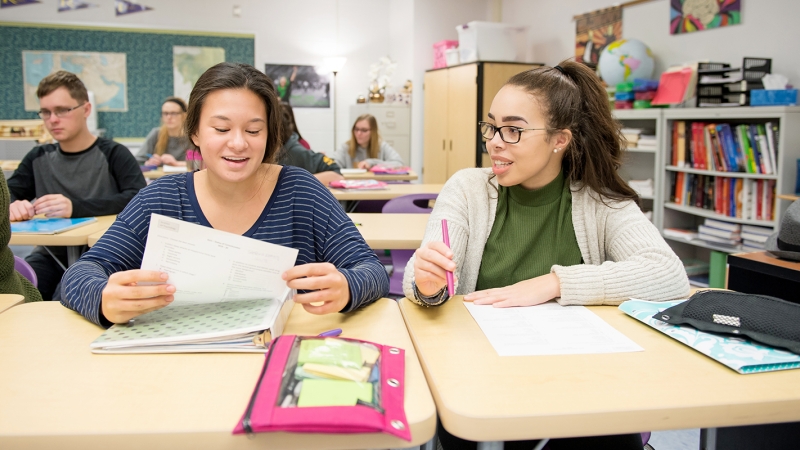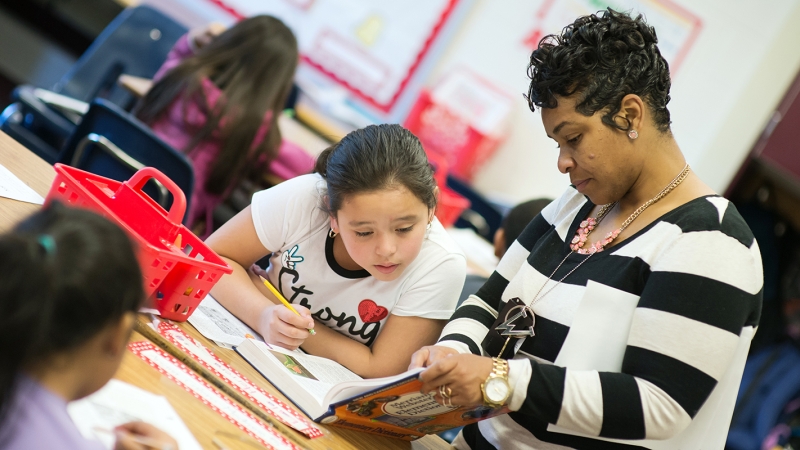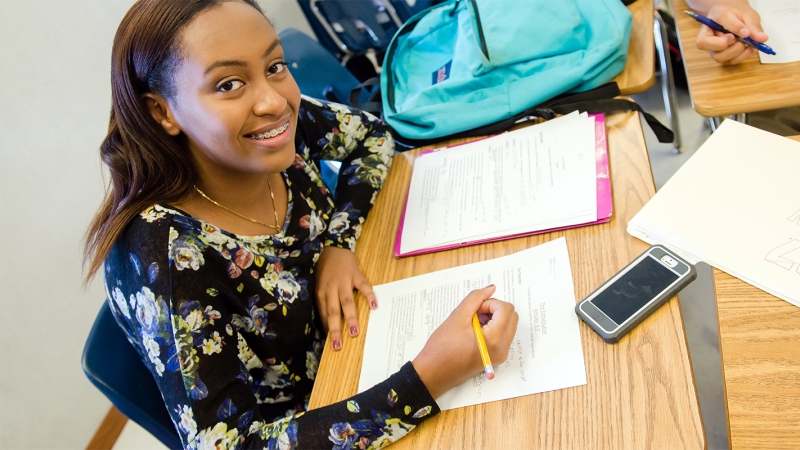
Core Instruction for Students with Dyslexia
In FCPS, high-quality core instruction is paramount. Students with dyslexia benefit tremendously from having access to both a strong structured literacy core program as well as evidence-based interventions to address their specific areas of need.
Elementary Core Literacy Instruction
FCPS’ approach to literacy acquisition is grounded in science-based reading research, implemented through a structured literacy model, and guided by three anchors: The Simple View of Reading (Gough, P. B., & Tunmer, W. E. 1986), The Four-Part Processing Model (Seidenberg & McCLelland 1989), and Scarborough’s Reading Rope (Scarborough, 2001).
FCPS elementary schools use a structured literacy approach to instruction for all students. The Equitable Access to Literacy plan was created to ensure that students receive explicit instruction in reading and writing to achieve proficiency in literacy and eliminate disproportionate outcomes based on race, gender, zip code, ability, socioeconomic status, or languages spoken at home.
In the primary grades, all students, including those with dyslexia, receive explicit phonological awareness and phonics instruction, though the frequency, intensity, and duration may differ depending on student need. All students need direct practice in reading words that contain the phonics patterns they are studying using decodable text (text with highly regular sound-symbol correspondence). This type of phonics instruction is provided through core instruction as well as through appropriately chosen interventions, as needed. To ensure mastery, teachers monitor student development and application of these word reading skills.
Students with dyslexia may have strong vocabularies and comprehension skills, and these strengths should be further developed with a focus on language comprehension. Within the core curriculum, language comprehension is further developed by explicit instruction that focuses on building background knowledge, word study, and grammar. Explicit lessons in writing, grammar, and editing/revising are included in the elementary English Language Arts core curriculum. All students, including students with dyslexia, should be provided an opportunity to build oral language skills through the use of read alouds and opportunities for discussion.
Secondary Core Literacy Instruction
FCPS secondary schools use a student-centered instructional model that emphasizes active learning and allows for the intentional embedding of literacy practices in order to foster student engagement. Many secondary students with dyslexia still need explicit reading instruction. In addition, they need frequent opportunities to engage with authentic texts to deepen their understanding of the discipline and its specific reading demands.
The following actions should take place so that secondary students with dyslexia continue to progress in the core instructional program:
- Integrate frequent use of authentic, content-area texts into class with opportunities for students to apply readings
- Model the use of reading/thinking strategies during disciplinary reading, and teach students to use these strategies to construct meaning from text
- Build and activate background knowledge and establish a purpose for reading
- Foster vocabulary development by promoting multiple exposures to words in a variety of contexts
Tools and Strategies for Core Instruction in Secondary Classrooms
- Sensory & Graphic Supports
- Anchor charts
- Graphic organizers
- Mentor texts
- Text features
- Visuals
- Word Walls
- Linguistic Supports
- Reading ladders
- Sentence frames
- Signal words
- Tier 2 words
- Text Sets
- Word parts
- Reading & Thinking Strategies
- Determining importance
- Inferring
- Making connections
- Monitoring comprehension
- Summarizing
- Text coding
- Visualizing
- Engagement & Interactive Supports
- Academic conversations
- Active listening
- Critical & creative thinking strategies
- Gradual release
- Shared reading
- Think aloud
- Wait time
Schools and families are reminded that students with dyslexia at any point on the continuum greatly benefit from core instruction from general education teachers in addition to intervention targeted to their specific needs.
Intensifying Word Instruction
General education teachers can use classroom assessments to detect difficulties in decoding, fluency and spelling. Identification of the characteristics of dyslexia and appropriate intervention is critical. Students demonstrating difficulties in decoding, fluency, or spelling may benefit from targeted word instruction. In elementary schools, this instruction is often called word study and is focused on teaching students spelling patterns. In secondary schools, this instruction is often called vocabulary instruction and is focused on teaching students the meanings of Latin and Greek root words and affixes. At either level, teachers may need to intensify this instruction to meet the needs of students with dyslexia.
When crafting word instruction for the specific needs of elementary students with dyslexia:
- Design part-to-whole (phonemes are blended in order to read and spell words) instruction
- Use multisensory (visual, auditory, tactile, and kinesthetic) instruction.
- Employ more direct, explicit, and systematic instruction.
- Continue phonemic awareness instruction (teach students how to blend, segment, and manipulate sounds in spoken words that contain the pattern to be learned.)
- Provide additional review and practice. This practice should include dictation so students can master spelling patterns and reading decodable text to reinforce these patterns in reading...
Secondary students who are not accurate and fluent in their decoding skills may still need instruction that emphasizes mastery of phonics and advanced word instruction to include the following content:
- phonological and phonemic awareness (blending, segmenting, and manipulating)
- sound/symbol associations (making connections between the sounds and the letters)
- syllables (types and rules for division)
- morphology (base words, roots, and affixes)
- syntax (grammar, sentence variation, and mechanics of language)
- semantics (meaning)
Balancing Instruction and Intervention
Because dyslexia occurs on a continuum, not all students with dyslexia need special education services, but most students with dyslexia will require explicit instruction in phonological skills through intensified word instruction. Many students may also require intervention in structured literacy programs. Finally, some students may benefit from classroom and testing accommodations such as extra time, audio books, and writing supports that will help them to compensate for their decoding and spelling difficulties.
Many students with dyslexia require intervention programs that are direct, explicit, cumulative, sequential, and multisensory in approach. For students with dyslexia, these programs should supplement rather than replace core literacy instruction. It is the work of the Responsive Instruction team, the 504 plan committee, or the Individualized Education Plan (IEP) team to determine the individualized balance of core instruction, structured intervention programming, and accommodations to help each student reach high levels of literacy achievement.
It is important to note that it is never too late to teach an individual with dyslexia using a structured literacy program. Accommodations can be used to help a student access grade-level content, but intervention is required to ensure the development of automatic word recognition and spelling skills. Learn more in the section entitled, “Interventions and Specialized Reading Programs.”
See the section entitled, “Dyslexia Resources” for books and websites that support phonological instruction.
© 2017 Fairfax County School Board. All rights reserved. This material may not be reproduced, displayed, modified or distributed without the express prior written permission of the copyright holder. For permission, contact the FCPS Department of Special Services, Office of Special Education Instruction, Willow Oaks Corporate Center, 8270 Willow Oaks Corporate Drive, Fairfax, VA 22031.





